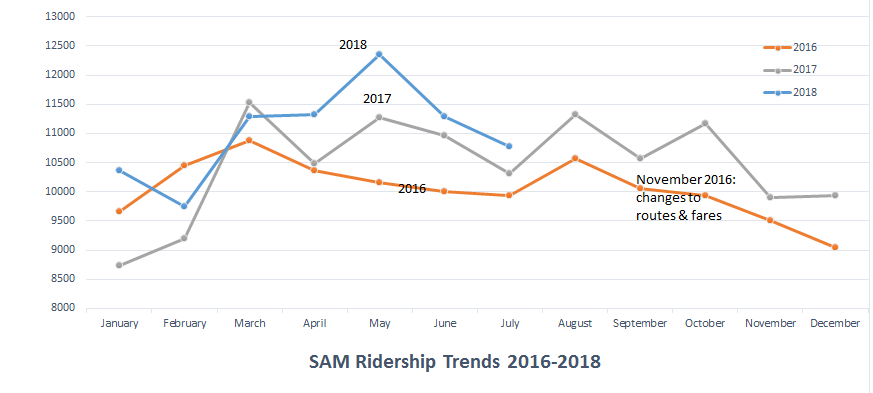For July, take a quick overview of the past fiscal year at Sandy Transit.
For the FY17 to FY19 biennium, state funding for Elderly and Disabled service (STF) experienced a 16% reduction. Federal formula funding for transportation remained the same, with no increase or decrease.
Therefore, Sandy Transit implemented many changes in service in November and December of 2016 and sought additional funding sources. These changes were aimed at increased ridership, especially on the SAM Gresham route, an expanded coverage model to better serve the fast-paced growth of development occurring in Sandy, a business-friendly fare structure and a business-friendly shopper shuttle including a family friendly trolley experience.
Through grant writing and diligent planning, the Transit Department has been able to primarily maintain service, add an in-town route and trolley, increase ridership, significantly increase our contingency fund, procure funding for: 2 new medium buses, 2 new heavy duty buses and a rebuild of the wash bay at the Operations Center.
These are Sandy Transit fiscal year highlights after route and fare structure changes (comparing FY17 to FY18):
- Overall ridership increased by 6.9%
- SAM Gresham route, the route hit hardest by the fare implemented in 2013, rebounded at 15% growth. SAM Gresham continues to charge a $1.00 fare for service to/from Gresham while providing free service in the commercial corridor of town. This route will experience expansion in January 2019 with new transportation funding provided by the Transportation Bill 2017 “Keep Oregon Moving”.
- SAM Estacada, underwent a slight decrease in runs, but expanded days and route changes in late 2016. This route also experienced a fare structure change. The route charges $1.00 to/from Estacada, while providing free in-town service. This route rebounded this fiscal year with a 4% increase. It will also experience expansion in January 2019 with new transportation funding provided by the Transportation Bill 2017 “Keep Oregon Moving”.
- SAM Shopper was introduced in December 2016. To compare a similar context of time, January to July of 2017 was compared to January to July of 2018. The SAM Shopper increased by 87%. This route continues in popularity and has been increased from a 30-minute loop to 45 minutes to accommodate the number of boardings taking place in a 3-hour window of time.
- STAR dial-a-ride service experienced a slight decrease in service (3.6%). This was the expected outcome with the introduction of the SAM Shopper. Due to the high demand of the STAR dial-a-ride and difficulty meeting the schedule needs, the SAM Shopper was designed to augment the dial-a-ride service and provide a fixed route for target populations (apartment complexes and retirement homes) to their shopping destinations. The route was designed using STAR ridership patterns.
- ED, Sandy Transit’s non-emergency medical ride program, provides medical rides for out-of-town services that are not available in Sandy. ED experienced a 10% reduction in rides this fiscal year compared to FY17. This reduction is due, in part, to the Sandy dialysis clinic accommodating more local patients. The ED program has seen increased demand for several years. In FY16 for example, ED provided 510 rides, compared to 1,013 in FY18. With the aging population, this service will continue to increase in demand. Currently, Sandy Transit provides medical rides for Transit customers (Sandy residents) as well as Sandy Community Center customers (Oregon Trail School District and Boring residents). Due to a lack of capacity (drivers), Sandy Transit cannot meet the current demand. We are exploring options to increase the availability of this service for our most vulnerable populations (frail elderly and disabled).
Other happenings in Sandy Transit:
SAM ridership continues to increase. SAM provided 10,874 rides in July 2018 compared to 10,032 rides in July 2017, an overall increase of 5.5%.The DoubleMap app is up and running. We are currently working on technical issues on some of the tablets but overall we are pleased with the application.
- 11 tablets equipped with GPS were mounted in SAM and MHX buses.
- 11 interior LED signs were also included for visual stop announcements.
- Exterior and interior automated voice stop announcements were installed.
- Customers can look up bus real-time arrival estimates, watch their bus in motion on the app and online, look up bus stop amenities, such as lighting and shelter descriptions and get push notifications to their device when a bus is delayed or re-routed.
- For in-house administration, many reporting features are included, bus and driver information (such as speeds; on-time performance) are available as well as the ability to communicate to passengers through the push notifications in real time.

